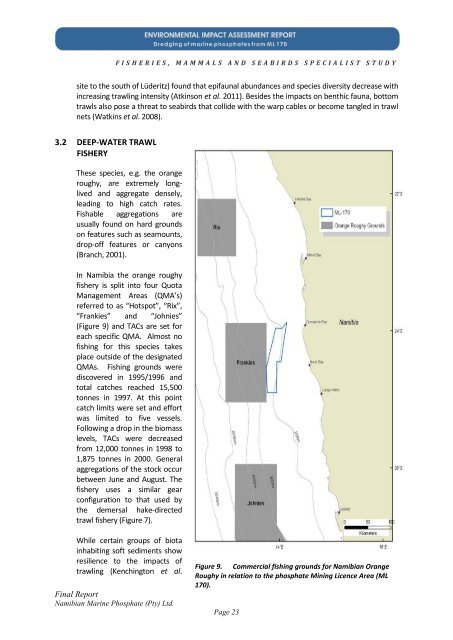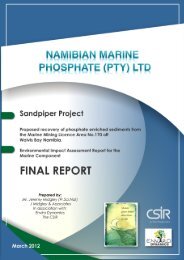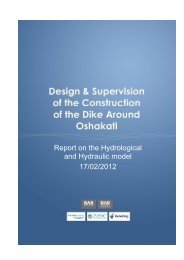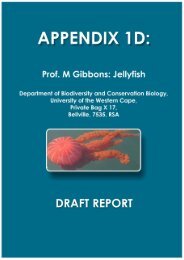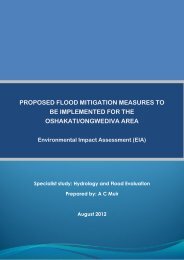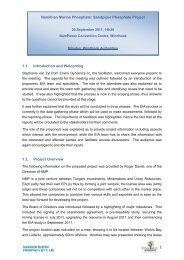Fisheries - Enviro Dynamics Namibia
Fisheries - Enviro Dynamics Namibia
Fisheries - Enviro Dynamics Namibia
Create successful ePaper yourself
Turn your PDF publications into a flip-book with our unique Google optimized e-Paper software.
F I S H E R I E S , M A M M A L S A N D S E A B I R D S S P E C I A L I S T S T U D Y<br />
site to the south of Lüderitz) found that epifaunal abundances and species diversity decrease with<br />
increasing trawling intensity (Atkinson et al. 2011). Besides the impacts on benthic fauna, bottom<br />
trawls also pose a threat to seabirds that collide with the warp cables or become tangled in trawl<br />
nets (Watkins et al. 2008).<br />
3.2 DEEP-WATER TRAWL<br />
FISHERY<br />
These species, e.g. the orange<br />
roughy, are extremely longlived<br />
and aggregate densely,<br />
leading to high catch rates.<br />
Fishable aggregations are<br />
usually found on hard grounds<br />
on features such as seamounts,<br />
drop-off features or canyons<br />
(Branch, 2001).<br />
In <strong>Namibia</strong> the orange roughy<br />
fishery is split into four Quota<br />
Management Areas (QMA’s)<br />
referred to as “Hotspot”, “Rix”,<br />
“Frankies” and “Johnies”<br />
(Figure 9) and TACs are set for<br />
each specific QMA. Almost no<br />
fishing for this species takes<br />
place outside of the designated<br />
QMAs. Fishing grounds were<br />
discovered in 1995/1996 and<br />
total catches reached 15,500<br />
tonnes in 1997. At this point<br />
catch limits were set and effort<br />
was limited to five vessels.<br />
Following a drop in the biomass<br />
levels, TACs were decreased<br />
from 12,000 tonnes in 1998 to<br />
1,875 tonnes in 2000. General<br />
aggregations of the stock occur<br />
between June and August. The<br />
fishery uses a similar gear<br />
configuration to that used by<br />
the demersal hake-directed<br />
trawl fishery (Figure 7).<br />
While certain groups of biota<br />
inhabiting soft sediments show<br />
resilience to the impacts of<br />
trawling (Kenchington et al.<br />
Final Report<br />
<strong>Namibia</strong>n Marine Phosphate (Pty) Ltd.<br />
Figure 9. Commercial fishing grounds for <strong>Namibia</strong>n Orange<br />
Roughy in relation to the phosphate Mining Licence Area (ML<br />
170).<br />
Page 23


